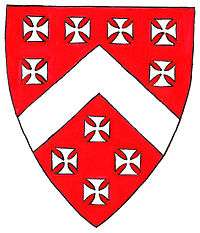William de Berkeley, 1st Marquess of Berkeley

William de Berkeley, 1st Marquess of Berkeley (1426 – 14 February 1492) was an English peer, given the epithet "The Waste-All" by the family biographer and steward John Smyth of Nibley.[1] He was buried at "St. Augustine's Friars, London" according to one source,[2] but most likely in the Berkeley family foundation of St Augustine's Abbey, Bristol.
Descent and Marriages
William of Berkley was born to James Berkeley, 1st Baron Berkeley and Lady Isabel Mowbray[3] at Berkeley Castle[4] in Berkeley, England in 1426.[5] His first marriage was in 1466 to Elizabeth West,[6] daughter of Reginald West, 6th Baron De La Warr, but he obtained a divorce on 20 November 1467.[7] In November 1468, he married Joan Strangeways,[8] daughter of Sir Thomas Strangeways and Lady Katherine Neville. After the death of his second wife, he married Anne Fiennes,[9] sister of Thomas Fiennes, 8th Baron Dacre, in circa 1486.[2]
Titles
William was invested as a Knight circa 1438.[5] William assumed the title of Baron Berkeley by writ after the death of his father James Berkeley, 1st Baron Berkeley on 22 October 1463.[10]
He was invested as a Knight Bachelor on 18 April 1475.[5] He was styled as Viscount of Catherlough (now known as County Carlow, Ireland) between 1481 and 10 February 1485.[11]
Williams was created Viscount Berkeley on 21 April 1481, as a Privy Counsellor (P.C.) on 5 March 1482/83, and as Earl of Nottingham on 28 June 1483.[5] He assumed the life office of Earl Marshal and Great Marshal of England on 19 February 1485/86. Finally, he was created Marquess of Berkeley on 28 January 1488/89.[5]
Disinherits brother
He had no surviving male issue, thus the marquesate and his other non-inherited titles became extinct on his death, but he had a younger brother, Maurice Berkeley, 3rd Baron Berkeley. He disinherited Maurice, as having brought shame on the noble House of Berkeley by marrying beneath his status Isabel Mead, daughter of Philip Mead of Wraxall an Alderman and Mayor of Bristol in 1459, 1462 and 1469.[12] In order to achieve this, the castle, lands and lordships composing the Barony of Berkeley he settled on King Henry VII and his heirs male, failing which to descend to his own rightful heirs. Thus, in 1553 on the death of King Edward VI, the unmarried grandson of Henry VII, the Berkeley inheritance returned to the family. Therefore, on the death of the 1st Marquis, only the de jure barony title was passed on to his younger brother Maurice, that is to say he was Baron Berkeley by right if not actually in possession of the baronial property. The 4th, 5th and 6th barons were also de jure only, with Henry (d.1613) becoming de facto 7th Baron in 1553.[13]
Accomplishments
On 20 March 1469/70 he was challenged by Thomas Talbot, 2nd Viscount Lisle to settle the claims to his great-uncle Thomas's estates, by combat. Thomas was killed in the combat.[5] The battle, known as the Battle of Nibley Green, is notable for being the last battle fought in England entirely between the private armies of feudal magnates.[14] William and Maurice were assisted at Nibley Green by a private army raised by Philip Mead, Maurice's father-in-law. It was surely a mark of ingratitude that William disinherited Mead's grandchildren.
Notes
- ↑ Smyth, John, The Lives of the Berkeleys, Lords of the Honour, Castle and Manor of Berkeley, in the County of Gloucester, from 1066 to 1618. First published 1618. Smyth attributed to each Berkeley lord a nickname, some favourable, some less so. Shortened to William 'the Wass all'(Lundy, 2011, p2795, citing GEC Peerage 2000, p133)
- 1 2 Lundy 2011, p. 2795 cites Cokayne 2000, p. 135.
- ↑ Lundy, Darryl. "Lady Isabel Mowbray". The Peerage.
- ↑ Lundy, Darryl. "pd76.htm#i5169". The Peerage.
- 1 2 3 4 5 6 Lundy 2011, p. 2795 cites Cokayne 2000, p. 133.
- ↑ Lundy, Darryl. "Elizabeth West". The Peerage.
- ↑ Lundy 2011, p. 2795 cites Cokayne 2000, p. 134.
- ↑ Lundy, Darryl. "Joan Strangeways". The Peerage.
- ↑ Lundy, Darryl. "Anne Fiennes". The Peerage.
- ↑ Burke, Bernard. A Genealogical History of the Dormant, Abeyant, Forfeited, and Extinct Peerages of the British Empire. London: Harrison, 1866. (p. 44) googlebooks.com Accessed 7 July 2007
- ↑ Charles Mosley, editor, Burke's Peerage, Baronetage & Knightage, 107th edition, 3 volumes (Wilmington, Delaware, U.S.A.: Burke's Peerage (Genealogical Books) Ltd, 2003), volume 1, page 348.
- ↑ "Mayors of Bristol since 1216". Bristol City Council. Retrieved 6 December 2009.
- ↑ Debrett's Peerage 1968, p.139, Berkeley, Baroness, Predecessors
- ↑ Cooke, Chapter V.
References
- Cooke, James Herbert. "Chapter V. The Battle of Nibley Green". A Sketch of the History of Berkeley, Its Castle, Church, and the Berkeley Family. Gloucester: John Bellows; Bristol and Clifton: R. W. Bingham; Berkeley: G. Sinderby. Retrieved August 2012. Check date values in:
|access-date=(help) - Lundy, Darryl (2 February 2011). "William de Berkeley, 1st and last Marquess of Berkeley". The Peerage. p. 2795. Retrieved August 2012. Check date values in:
|access-date=(help)- Cokayne, G.E.; et al., eds. (2000). The Complete Peerage of England, Scotland, Ireland, Great Britain and the United Kingdom, Extant, Extinct or Dormant. II (new ed., 13 volumes in 14 (1910–1959; reprinted in 6 volumes ed.). Gloucester, U.K.: Alan Sutton Publishing. p. 133.
| Political offices | ||
|---|---|---|
| Preceded by The Duke of Norfolk |
Earl Marshal 1486–1492 |
Succeeded by The Duke of York |
| Peerage of England | ||
| New creation | Marquess of Berkeley 1489–1492 |
Extinct |
| Earl of Nottingham 4th creation 1483–1492 | ||
| Viscount Berkeley 1481–1492 | ||
| Preceded by James Berkeley |
Baron Berkeley 1463–1492 |
Succeeded by Maurice Berkeley |
| Peerage of Ireland | ||
| New creation | Viscount of Catherlough probably only as style 1481–1485 |
Extinct |